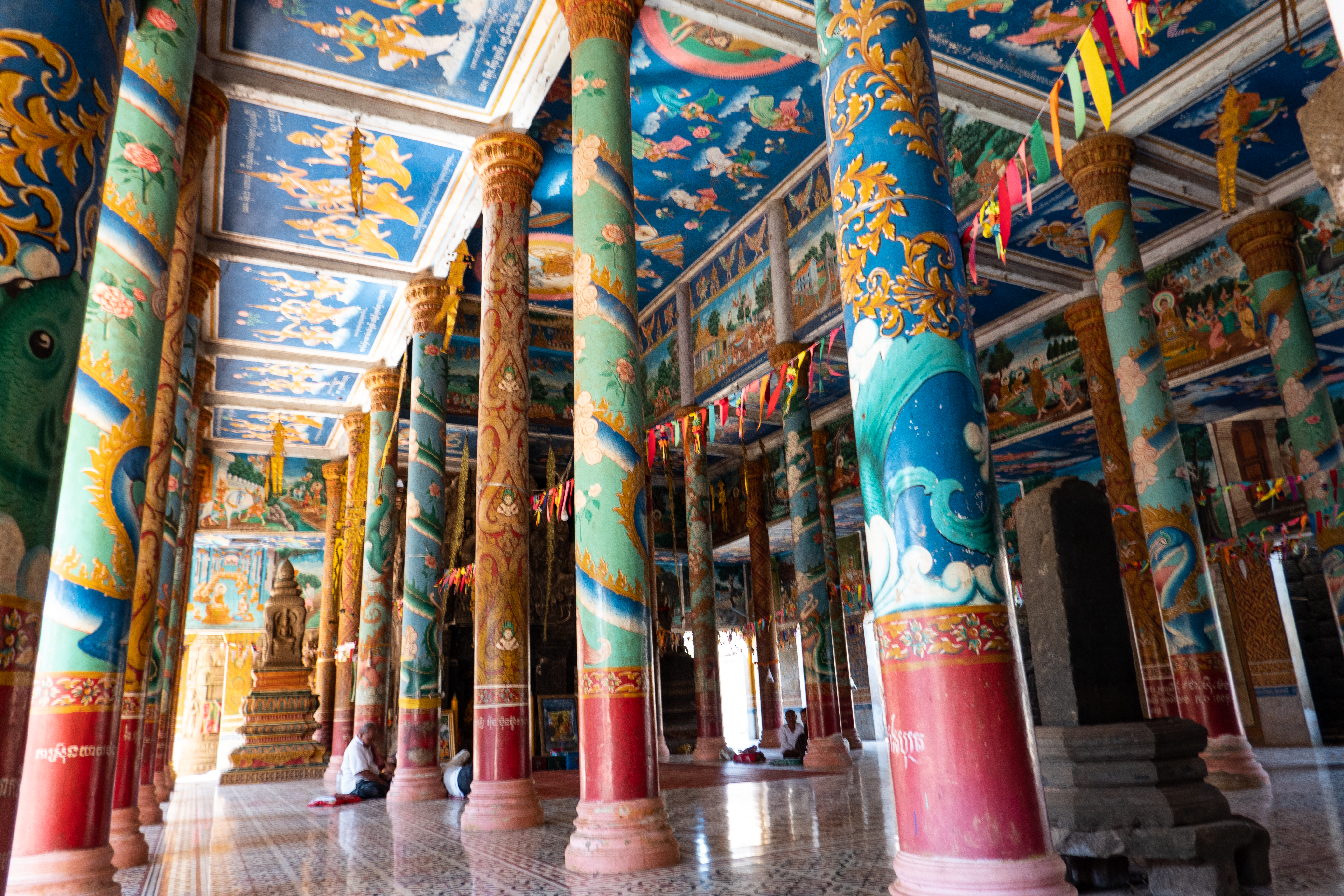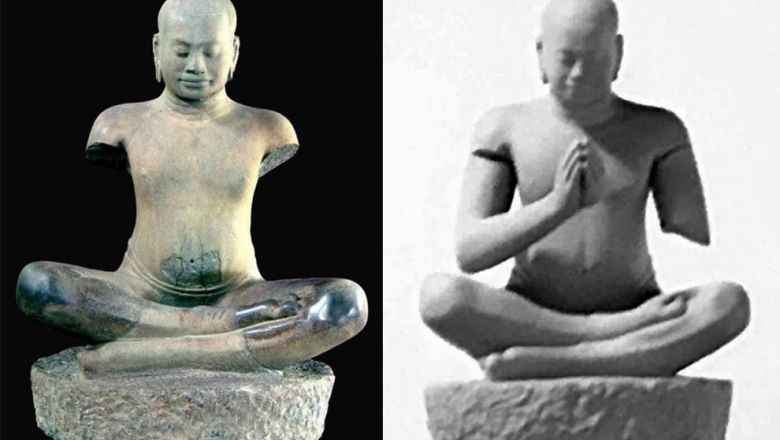|
Banteay Prey Nokor
Banteay Prei Nokor ( km, បន្ទាយព្រៃនគរ) is an ancient temple complex in the northwest of Kompong Cham, Cambodia. Known locally as temple of "Wat Nokor in Khum of Kompong Siem", or "Wat Angkor", around 2km from the provincial capital Kampong Cham (city). though a sign at the entrance now officially designates the name of the temple as Nokor Bachey Temple ( km, ប្រាសាទនគរបាជ័យ). Layout The complex faces east at a bearing of 84.5°E, and covers 15ha. the site is composed of an outer rectangular laterite wall approximately 420x370m, an inner wall approximately 100x130m. A large reservoir or Baray ( km, បារាយណ៍) some 950 meters long and 480 meters wide is located 350 meters east of the site. Now abandoned, the reservoir area was used in the mid 20th century as a hippodrome, evidence of which can still be seen by visitors. History The monument was built out of sandstone and laterite, and dates from t ... [...More Info...] [...Related Items...] OR: [Wikipedia] [Google] [Baidu] |
Buddhism
Buddhism ( , ), also known as Buddha Dharma and Dharmavinaya (), is an Indian religion or philosophical tradition based on teachings attributed to the Buddha. It originated in northern India as a -movement in the 5th century BCE, and gradually spread throughout much of Asia via the Silk Road. It is the world's fourth-largest religion, with over 520 million followers (Buddhists) who comprise seven percent of the global population. The Buddha taught the Middle Way, a path of spiritual development that avoids both extreme asceticism and hedonism. It aims at liberation from clinging and craving to things which are impermanent (), incapable of satisfying ('), and without a lasting essence (), ending the cycle of death and rebirth (). A summary of this path is expressed in the Noble Eightfold Path, a training of the mind with observance of Buddhist ethics and meditation. Other widely observed practices include: monasticism; " taking refuge" in the Buddha, the , and the ; ... [...More Info...] [...Related Items...] OR: [Wikipedia] [Google] [Baidu] |
Sandstone
Sandstone is a clastic sedimentary rock composed mainly of sand-sized (0.0625 to 2 mm) silicate grains. Sandstones comprise about 20–25% of all sedimentary rocks. Most sandstone is composed of quartz or feldspar (both silicates) because they are the most resistant minerals to weathering processes at the Earth's surface. Like uncemented sand, sandstone may be any color due to impurities within the minerals, but the most common colors are tan, brown, yellow, red, grey, pink, white, and black. Since sandstone beds often form highly visible cliffs and other topographic features, certain colors of sandstone have been strongly identified with certain regions. Rock formations that are primarily composed of sandstone usually allow the percolation of water and other fluids and are porous enough to store large quantities, making them valuable aquifers and petroleum reservoirs. Quartz-bearing sandstone can be changed into quartzite through metamorphism, usually related to ... [...More Info...] [...Related Items...] OR: [Wikipedia] [Google] [Baidu] |
Dam Din
Dam Din ( km, ដាំដី), also known as Chao Ponhea Techo Chrek Dey or Techo Dam Din, or the underground-traveling Khmer, is a legendary figure from Khmer history, usually described as the general who opposed Phra Ruang who wanted to establish the first Thai kingdom free from the rule of the ancient Khmer Empire. Origins The story of Techo Dam Din originates from some versions of the Thai legend of Phra Ruang; the earliest known written account that mentions the figure is found in the Northern Chronicles compiled by Phra Wichianpricha (Noi) in 1807. The document refers to the figure as ''Khom dam din'' ('earth-diving Khmer'), and makes no mention of the name Techo. Khmer versions of the tale are found in the Cambodian Royal Chronicles; it is not known from Khmer folktales. The earliest known mention is found in the chronicle of Vatt Kok Kak, which was compiled in 1869 during the reign of King Norodom, and several later versions reproduce or build upon the story. The ... [...More Info...] [...Related Items...] OR: [Wikipedia] [Google] [Baidu] |
World Heritage
A World Heritage Site is a landmark or area with legal protection by an international convention administered by the United Nations Educational, Scientific and Cultural Organization (UNESCO). World Heritage Sites are designated by UNESCO for having cultural, historical, scientific or other form of significance. The sites are judged to contain "cultural and natural heritage around the world considered to be of outstanding value to humanity". To be selected, a World Heritage Site must be a somehow unique landmark which is geographically and historically identifiable and has special cultural or physical significance. For example, World Heritage Sites might be ancient ruins or historical structures, buildings, cities, deserts, forests, islands, lakes, monuments, mountains, or wilderness areas. A World Heritage Site may signify a remarkable accomplishment of humanity, and serve as evidence of our intellectual history on the planet, or it might be a place of great natural beauty. As ... [...More Info...] [...Related Items...] OR: [Wikipedia] [Google] [Baidu] |
UNESCO
The United Nations Educational, Scientific and Cultural Organization is a specialized agency of the United Nations (UN) aimed at promoting world peace and security through international cooperation in education, arts, sciences and culture. It has 193 member states and 12 associate members, as well as partners in the non-governmental, intergovernmental and private sector. Headquartered at the World Heritage Centre in Paris, France, UNESCO has 53 regional field offices and 199 national commissions that facilitate its global mandate. UNESCO was founded in 1945 as the successor to the League of Nations's International Committee on Intellectual Cooperation.English summary). Its constitution establishes the agency's goals, governing structure, and operating framework. UNESCO's founding mission, which was shaped by the Second World War, is to advance peace, sustainable development and human rights by facilitating collaboration and dialogue among nations. It pursues this objective t ... [...More Info...] [...Related Items...] OR: [Wikipedia] [Google] [Baidu] |
Bayon
The Bayon ( km, ប្រាសាទបាយ័ន, ) is a richly decorated Khmer temple related to Buddhism at Angkor in Cambodia. Built in the late 12th or early 13th century as the state temple of the King Jayavarman VII ( km, ព្រះបាទជ័យវរ្ម័នទី ៧), the Bayon stands at the centre of Jayavarman's capital, Angkor Thom ( km, អង្គរធំ).Higham, C., 2001, The Civilization of Angkor, London: Weidenfeld & Nicolson, , p.121Higham, C., 2014, Early Mainland Southeast Asia, Bangkok: River Books Co., Ltd., pp.378-382 The Bayon's most distinctive feature is the multitude (4 on each tower pointing to the 4 sides) of serene and smiling stone faces of Brahma on the many towers which jut out from the upper terrace and cluster around its central peak.Freeman and Jacques, p.78. The main conservatory body, the Japanese Government Team for the Safeguarding of Angkor (the JSA) has described the temple as "the most striking expression of the ba ... [...More Info...] [...Related Items...] OR: [Wikipedia] [Google] [Baidu] |
Jayavarman VII
Jayavarman VII, posthumous name of Mahaparamasaugata ( km, ជ័យវរ្ម័នទី៧, c. 1122–1218), was king of the Khmer Empire. He was the son of King Dharanindravarman II (r. 1150–1160) and Queen Sri Jayarajacudamani. He was the first king devoted to Buddhism, as only one prior Khmer king was a Buddhist. He then built the Bayon as a monument to Buddhism. Jayavarman VII is generally considered the most powerful of the Khmer monarchs by historians. His government built many projects including hospitals, highways, rest houses and temples. With Buddhism as his motivation, King Jayavarman VII is credited with introducing a welfare state that served the physical and spiritual needs of the Khmer people. Defeat of the Cham and coronation In 1177 and again in 1178, the Cham invaded the Khmer Empire. In 1177, Champa King Jaya Indravarman IV launched a surprise attack on the Khmer capital by sailing a fleet up the Mekong River, across Lake Tonlé Sap, and then up ... [...More Info...] [...Related Items...] OR: [Wikipedia] [Google] [Baidu] |
Laterite
Laterite is both a soil and a rock type rich in iron and aluminium and is commonly considered to have formed in hot and wet tropical areas. Nearly all laterites are of rusty-red coloration, because of high iron oxide content. They develop by intensive and prolonged weathering of the underlying parent rock, usually when there are conditions of high temperatures and heavy rainfall with alternate wet and dry periods. Tropical weathering (''laterization'') is a prolonged process of chemical weathering which produces a wide variety in the thickness, grade, chemistry and ore mineralogy of the resulting soils. The majority of the land area containing laterites is between the tropics of Cancer and Capricorn. Laterite has commonly been referred to as a soil type as well as being a rock type. This and further variation in the modes of conceptualizing about laterite (e.g. also as a complete weathering profile or theory about weathering) has led to calls for the term to be abandoned alto ... [...More Info...] [...Related Items...] OR: [Wikipedia] [Google] [Baidu] |
Hippodrome
The hippodrome ( el, ἱππόδρομος) was an ancient Greek stadium for horse racing and chariot racing. The name is derived from the Greek words ''hippos'' (ἵππος; "horse") and ''dromos'' (δρόμος; "course"). The term is used in the modern French language and some others, with the meaning of "horse racecourse". Hence, some present-day horse-racing tracks also include the word "hippodrome" in their names, such as the Hippodrome de Vincennes and the Central Moscow Hippodrome. In the English-speaking world the term is occasionally used for theatres. Overview The Greek hippodrome was similar to the Roman version, the circus. (The hippodrome was not a Roman amphitheatre, which was used for spectator sports, executions, and displays, or a Greek or Roman semicircular amphitheater used for theatrical performances.) The Greek hippodrome was usually set out on the slope of a hill, and the ground taken from one side served to form the embankment on the other side. One en ... [...More Info...] [...Related Items...] OR: [Wikipedia] [Google] [Baidu] |
Baray
A ''baray'' ( km, បារាយណ៍) is an artificial body of water which is a common element of the architectural style of the Khmer Empire of Southeast Asia. The largest are the East Baray and West Baray in the Angkor area, each rectangular in shape, oriented east-west and measuring roughly five by one and a half miles. Historians are divided on the meaning and functions of barays. Some believe that they were primarily spiritual in purpose, symbolizing the Sea of Creation surrounding Mount Meru, font of the Hindu cosmos. Others have theorized that they held water for irrigation of fields. Others believe that it was used to store water, the current most popular theory. It is possible that the function was a combination of these explanations, or others. The building of barays might have originated from the tradition of building large reservoirs called dighi in Eastern India. See also * Srah and baray * Temple tank Temple tanks are wells or reservoirs built as part of ... [...More Info...] [...Related Items...] OR: [Wikipedia] [Google] [Baidu] |

Saunders_Quarry-1.jpg)



